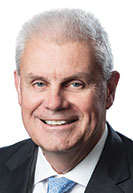Subscriber Benefit
As a subscriber you can listen to articles at work, in the car, or while you work out. Subscribe NowWhen COVID-19 upended the economy last year, banks steeled themselves for an anticipated spike in loan defaults.
Those fears never came to pass. In fact, the opposite has happened: Loan defaults are at historic lows right now, both in Indiana and nationwide.

“It is a very, very strong time right now,” said Mike Ash, the Indianapolis-based market president for Fifth Third Bank.
Ash, and other Indiana bankers, cite federal COVID-19 relief measures as a big reason—but not the only one. And, though no one foresees a dramatic economic decline in the foreseeable future, they’re also keeping tabs on a number of factors they say could swing things in the other direction.
Ash said that, while Fifth Third’s loan portfolio was performing well before the pandemic, credit quality has actually improved during the pandemic. Last quarter, the bank’s net charge-off rate—the proportion of debt unlikely to be paid back— stood at 0.08%.
“It’s like a 50-year low for us,” Ash said.
The same situation is playing out at other banks around the state and beyond.

Nationally, the net charge-off rate last quarter hit a historic low of 0.19%, which was the fifth straight quarter of improvement, according to the Federal Deposit Insurance Corp.’s latest quarterly banking profile, released last week.
“I think everyone expected that it was just going to be a tidal wave of bad loans,” said Indianapolis attorney John Tanselle, who specializes in banking law and is a partner at law firm Smith Admundsen LLC. “I thought we were going to really hit a wall. I’m so glad we didn’t.”
By comparison, the net charge-off rate swelled to a historic 3% in the fourth quarter of 2009 during the Great Recession. Put another way, net charge-offs from bad loans represented 3% of all loans and leases in that quarter—the highest it’s been since the Federal Deposit Insurance Corp. began keeping records on this metric in 1984.
Tanselle and others cite federal COVID-19 relief efforts—including the paycheck protection plan, individual stimulus payments and enhanced unemployment benefits—as a big factor in keeping loan defaults low during last year’s recession.
“All of those programs provided a lot of flexibility, a lot of liquidity, to both consumers and businesses,” said Mike Stewart, president at Muncie-based First Merchants Bank.

For the year to date, First Merchants’ net charge-off rate is 0.07%. Last quarter, its rate was negative 0.01%, meaning the bank recovered slightly more from its bad loans than it lost from them.
Stewart said he thinks memories of the Great Recession also helped ease the downturn this time around. Once it was evident the pandemic was going to disrupt the economy, he said, companies immediately began to reduce their capital expenditures, cut back on distributions and dividend payments, manage inventory levels and take other steps that helped them better weather the storm.
Though some companies were still hit very hard by the pandemic, Stewart said, “they still have memories of 2008, 2009 and 2010. They were really quick to react.”
At the same time, stay-at-home orders, travel bans and the like kept spending lower than usual.
“People tended to be paying down debt rather than getting in debt,” Ash said.

The short duration of the recession also helped keep loan defaults low, said Mark Bruin, president and CEO of The National Bank of Indianapolis. “It was a painful, deep recession, but it was over in 90 days, which is pretty unusual for an economic downturn.”
Bruin said his bank’s net charge-off rate for the year to date is zero.
Dan Maddox, chairman and CEO of New Castle-based Citizens State Bank, sees two other potential factors keeping default rates so low: the strength of the housing market and historically low interest rates.
In response to the emerging pandemic, the Federal Reserve in March 2020 lowered interest rates to near zero.
“It was a pretty historic rapid move, right when things started to lock up,” Maddox said.
And because interest rates dropped so low, both commercial and consumer borrowers were able to refinance their debt and potentially reduce monthly payments.
“I think that’s been a big contributor” to keeping default rates low, Maddox said.
The hot housing market has also provided another tool for borrowers, he said. Homeowners who might be struggling to make a mortgage payment have generally found it easy to sell their home for a good price. This can also sometimes be a solution for commercial real estate, he said.
“They have a pretty easy out,” Maddox said. “They can sell the property and make the loan whole, and often exit with a little cash.”
He added that his bank hasn’t seen a lot of customers use this option during the pandemic.
Maddox said his bank’s net charge-off rate was “essentially zero” last quarter and has remained consistently low since the beginning of the pandemic.
Nothing lasts forever, however. Bankers say they are keeping their eyes on a number of factors that could cause default rates to creep up, including inflation and the supply-chain and labor problems that have plagued the economy this year.
Any of these factors—or something else entirely—could hurt the economy, which in turn could cause loan default rates to rise.
“The thing that I’ve got my eye on is a policy mistake out of Washington, D.C.,” Bruin said. He doesn’t have anything in particular in mind, he said, but believes something like a too-rapid interest-rate hike, new federal legislation or a geopolitical disruption could trigger a rise in loan defaults.

“I think it’s going to be interesting to see what happens in the fourth quarter,” said Amber Van Til, president and CEO of the Indianapolis-based Indiana Bankers Association.
Van Til said she’s also watching the emerging omicron coronavirus variant as a possible disruptor.
She said she wouldn’t be surprised if credit conditions decline modestly, though she thinks loan performance will remain strong.
Another potential threat lies within the banking system itself.
In a report issued this week by the Office of the Comptroller of the Currency, the bank regulator said it believes banks are facing “moderate” credit risk because they might be tempted to lower their credit standards.
Bankers say they don’t see any indication that lenders are poised to loosen their underwriting.
“For the most part, I think most banks are pretty disciplined in terms of their credit profile,” Ash said.
But this is an explicit concern for the OCC.
The OCC report noted that, though credit quality has held up during the pandemic, “the duration of the pandemic, its impact on demand for credit, and the effects of nonbank competition may put pressure on some banks’ willingness and ability to maintain credit discipline as the economy recovers and loan growth opportunities return.”
In the end, it’s hard to say what might cause conditions to change, or when it might happen.
“Nobody knows,” Tanselle said. “If they can figure that out, they ought to be chairing the Federal Reserve.”•
Please enable JavaScript to view this content.

No one is defaulting because, as stated, everyone is on the dole. In addition one can simply advise your mortgagee that Covid has effected you and you aren’t going to be paying your mortgage. Just add the principal to my loan.
Moreover, what about all the vacant office space; No rent no mortgage payment. Just give it back to the lender. ( remember 1990 pretty much every nonowner occupied building here and across the country went back to the lender). The difference today is the theory we are all better off working from home. This will insure the building will stay dark. Work from home. Do all Shopping on line. We only need our autos to go on vacation. Just relax the government will take care of everything. Just look at the booming economies in Cuba, Venezuela, etc
It is good news until you realize that the debt of every taxpayer is about $230,000 with zero hopes that will be repaid. Robbing Peter to pay Paul as Paul A. says, everyone is on the dole. It will get worse very soon and in fact is already here as inflation is the regressive tax that destroys lives and futures.